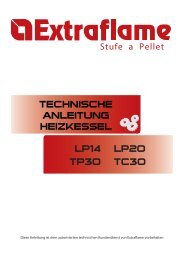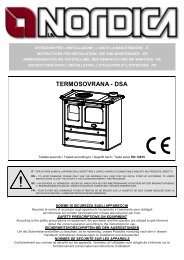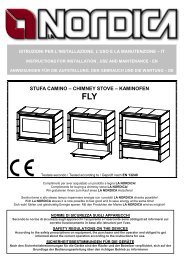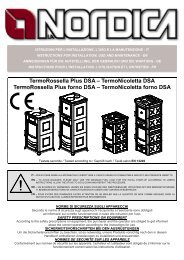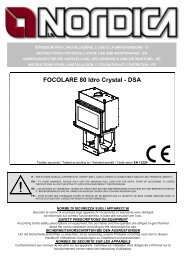1 - HJS-Internethandel
1 - HJS-Internethandel
1 - HJS-Internethandel
Create successful ePaper yourself
Turn your PDF publications into a flip-book with our unique Google optimized e-Paper software.
TERMOSUPREMA COMPACT DSA / ITALY TERMO DSA<br />
cannot block the primary air intake for combustion. The primary air also keeps the flame alive.<br />
The primary air register must be open a little during wood combustion, as otherwise the wood burns too quickly and the thermocooker may<br />
overheat.<br />
SECONDARY Air Register (upper knob on the furnace door Picture 1 at page 51 pos. B).<br />
This knob must be open (i.e. turned completely to the right), in particular for the combustion of wood (see paragraph 8.1). The secondary<br />
air, passing between the double glass of the fire door, heats up and triggers the dual combustion, keeping the glass clean at the same time<br />
(register open).<br />
AUTOMATIC Thermostat (placed in the upper right-hand part of the back Picture 1 at page 51 pos. C)<br />
The thermostat has the task of automatically increasing or decreasing combustion.<br />
Dependent on the position chosen, the thermostat will act on the valve which regulates the intake of air into the furnace, placed on the<br />
back of the cooker. Turn it in a clockwise direction from 0 to 5 to make up the fire and in an anti-clockwise direction to reduce combustion.<br />
As this is an extremely precise device, it is advisable to turn it carefully and never force the knob.<br />
FLUE GAS Register ( Picture 1 at page 51 Pos.D)<br />
(Conversion from the cooker HOTPLATE USE – OVEN USE function to the cooker HEATING function)<br />
In the central part of the instrument panel, there is the flue gas register, which can be recognised from its enamelled, labelled knob.<br />
When the register is positioned to the LEFT (on the pan symbol), the combustion gases flow above and around the oven (oven function<br />
– HOTPLATE USE – OVEN USE); when positioned to the RIGHT (on the water symbol), the gases flow near the boiler, increasing the<br />
temperature evenly, favouring water heating inside it (cooker function HEATING USE).<br />
IGNITION Register ( Picture 1 at page 51 pos. E).<br />
On the front of the cooker, between the protective handrail and the flue gas register, there is the ignition register control lever, which can<br />
be recognised by a chrome-plated knob.<br />
This register must only be used to facilitate the ignition of fuel in the cooker. Pull the lever outwards from the cooker (register open).<br />
IMPORTANT : during normal cooker operation, the register lever must remain completely inserted (pushed inwards on the cooker). In this<br />
way avoiding excessive fuel consumption and poor thermocooker output (register closed).<br />
5. FLUE<br />
Essential requirements for correct appliance operation:<br />
• the internal section must preferably be circular;<br />
• the appliance must be thermally insulated and impermeable and built with suitable materials which are resistant to heat, combustion<br />
products and any condensation;<br />
• there must be no narrowing and vertical passages with deviations must not be greater than 45°;<br />
• if already used, it must be clean;<br />
• the technical data from the instruction manual must be respected;<br />
If the flues are of a square or rectangular section, the internal edges must be rounded with a radius of not less than 20 mm.<br />
For the rectangular section, the maximum ratio between the sides must be ≤ 1.5.<br />
A section which is too small causes a reduction in draught. A minimum height of 4 m is advisable.<br />
The following materials are FORBIDDEN and compromise the good operation of the appliance: asbestos cement, galvanised steel, rough<br />
and porous internal surfaces. Picture 9 at page 54 shows some example solutions.<br />
The minimum section must be 4 dm 2 (for example 20x20 cm) for appliances whose pipe dimensions are less than 200 mm, or 6.25<br />
dm 2 (for example 25x25 cm) for appliances with a diameter of more than 200 mm.<br />
The draught created by your flue must be sufficient but not excessive.<br />
A section of the flue which is too large can present a volume which is too large to heat and therefore cause operating difficulties for the<br />
appliance; to avoid this, it is necessary to intubate the appliance for its entire height. A section which is too small causes a reduction in<br />
draught.<br />
The flue must be at a suitably distance from flammable or combustible material using suitable insulation or an air space.<br />
It is FORBIDDEN to pass system piping or air ducts inside the flue. It is also forbidden to create moveable or fixed openings on the flue<br />
itself, for the connection of further different appliances.<br />
5.1. CHIMNEY POT<br />
The flue draught depends on the suitability of the chimney pot.<br />
It is therefore essential that, if built in a handcrafted way, the exit section is more than twice the internal section of the flue (Picture 10 at page 54).<br />
As it must always go past the ridge of the roof, the chimney pot must ensure exhaust even in the presence of wind(Picture 11 at page 55).<br />
The chimney pot must meet the following requirements:<br />
• have an internal section equivalent to that of the chimney.<br />
• have a useful exit section of double the internal section of the flue.<br />
• be built so as to prevent rain, snow or any foreign body entering the flue.<br />
• be easy to inspect, for any maintenance and cleaning operations.<br />
5.2. CONNECTION TO THE CHIMNEY<br />
Products with automatic door closing (type 1) must operate, for safety reasons, with the furnace door closed (except during the fuel loading<br />
or ash removal phases).<br />
18 7095802 - Rev.07 - 05/2011 - IT-EN-DE-FR



